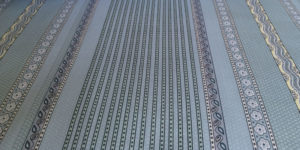 Satin is a fabric that is sewn from high quality silk or cotton fiber. Thanks to the long-fiber structure, the fabric is smooth to the touch with a characteristic satin sheen.
Satin is a fabric that is sewn from high quality silk or cotton fiber. Thanks to the long-fiber structure, the fabric is smooth to the touch with a characteristic satin sheen.
The Chinese first began to use it in the 12th century for sewing clothes during rituals. The high cost of the finished product did not allow ordinary residents to wear such clothes. Satin began to be exported to Europe at the end of the 12th century, and in the middle of the 19th century its production was patented and introduced for the creation of festive dresses and exclusive lingerie.
In the 20th century, production increased, and finished products became more accessible to ordinary residents.
Depending on the type of material, different raw materials are used for its production. The vast majority of products contain cotton threads, the quantity of which determines the appearance of the satin and its quality. The most expensive is considered natural satin, consisting of cotton without the addition of synthetic materials.
For its production, a special technology of weaving twisted threads of different thicknesses is used. As a result, the finished canvas has a glossy surface and smooth texture. The density of satin is adjusted during its manufacture depending on the number of cotton threads; usually, from 85 to 200 threads are used to sew one square centimeter of fabric.
Cotton threads that have undergone preliminary mercerization are used as raw materials. This process involves soaking the fabric in an alkaline solution and acid using the John Mercer technology. This method helps to increase the strength of the finished product, as well as prepare it for painting.
The final process is bleaching the material for applying paint, as well as decorating with patterns and colors. Dyed satin is dipped in a special solution to protect the surface from future washes.
Among the advantages of the fabric it should be noted:
The aesthetic appearance and its cost depend on the method of its manufacture. Satin is the most popular type of material in Europe, produced in different price categories. The cheapest samples are made from 85 - 170 threads per square centimeter. More durable types consist of 170 - 200 twisted threads. There are 6 main types of satin.
Ordinary
Classic satin is the most affordable and popular material, which is made from cotton threads weaving from 85 to 130 pieces per square centimeter. It is characterized by an average degree of smoothness of the sides, external gloss and strength. After washing, it prevents the appearance of “pellets” on the surface.
Printed
The composition of the more durable sample has 130-170 twisted threads and belongs to the standard group of fabrics for bed linen. Features – durable enough for long-term use, dyed with reactive printing, ensuring that the design maintains high quality after a large number of washes.
Printed
Material with a number of weaving threads from 130 to 170 looks beautiful and harmonious, and belongs to the more expensive varieties of material. This composition is hygroscopic and light.
Satin jacquard
The technological composition of the fabric ranges from 170 to 220 threads. The finished fabric has a noble satin shine and is highly durable. To apply the pattern, special jacquard machines are used; it belongs to exclusive premium class fabrics.
Mako-satin
The composition includes Egyptian cotton threads, woven using a special reactive technology. The fabrics are characterized by increased properties of softness and smoothness, the finished products belong to the elite category.
Silk-satin
Thanks to the unique combination of cotton and silk, without the addition of other materials, it is possible to create a more durable fabric with an impeccable appearance. Its cost is the highest of all types of material.
In addition to the listed types of satin, there are many others: crepe, double, dress, lining and others.
Area of application and fabric care methods
Thanks to its unique properties, diversity and different levels of strength, satin is a popular material for sewing a wide range of things. It can be found when sewing bed linen, dresses, clothes for children, curtains and tablecloths. High-quality application of drawings allows you to use the item for a long time without losing its aesthetic appearance.
To extend the service life of the product, we recommend following the general recommendations of the manufacturers:
Conclusion
Satin fabrics are in demand and one of the best types of textiles for sewing a large category of goods. The use of different densities of twisted threads makes it possible to create a unique type of material that is ideally suited to the individual needs of a wide range of consumers.